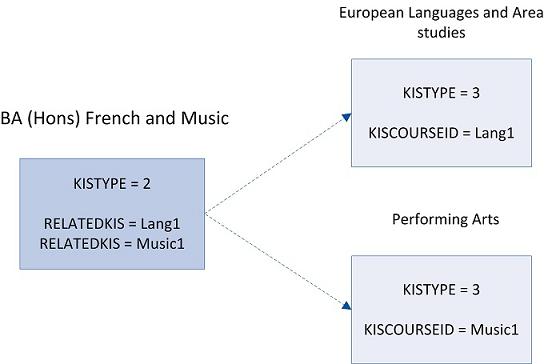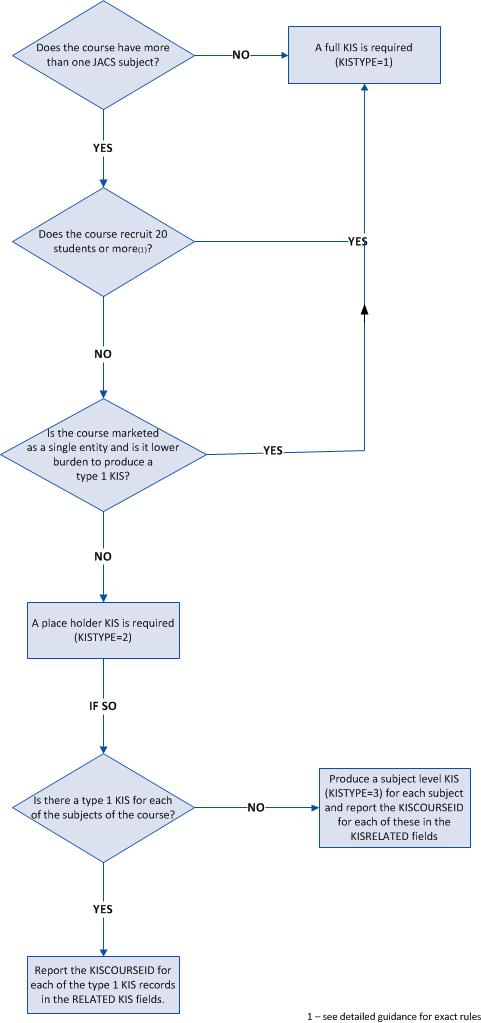KIS record 2016/17 - Guidance on which KISTYPE levels
KIS record 2016/17 - Guidance on which KISTYPE levels
Version 1.1 Produced 2016-03-31
KIS types
There are three different types of KIS records (defined and identified by KISCourse.KISTYPE) that can be returned for any given course. A course can only have one KISTYPE, and this is dependent on the nature of the course.
There are three types of KIS and further descriptions of these are given below:
- KISTYPE 1 - Full course level KIS
- KISTYPE 2 - Multiple subject course placeholder KIS
- KISTYPE 3 - Subject level KIS.
In most cases, KISTYPE 1 is the preferred method of returning a course.
KISTYPE 1 - Full course level KIS
KISTYPE 1s are full KIS records required for specific courses.
The following courses require a KISTYPE 1 KIS submission:
- All single subject courses (those with only one JACS code recorded for the course on the HESA Student Record) regardless of intake size
- All multiple subject courses (those with more than one JACS code recorded for the course on the HESA Student Record) where the intake size is greater than 20* students, providers may choose to return a KISTYPE=1 record for courses with fewer than 20 entrants
- All undergraduate teacher training courses (KISCourse.TTCID = 1 or 2) regardless of the number of JACS codes or intake size
- All medical programmes that contain a pre-clinical and clinical element and the distinction in JACS between the clinical and pre-clinical codes is the only reason why the course has multiple JACS codes.
When courses link to multiple HESA/ILR courses with different KISCourse.JACS codes, it is normally necessary to treat the courses as a KISCourse.KISTYPE 2 and link to the most appropriate KISCourse.KISTYPE 3 (KISTYPEs are described below). Note where this has arisen due to data error then the courses with the erroneous subject codes should be removed. An exception is allowed where the course generates course level information for all data published on Unistats.
KISTYPE 2 - Multiple subject course placeholder KIS
KISTYPE 2s are 'placeholders' for multiple subject courses for which a KISTYPE 1 record is not required i.e. the intake size is less than 20 students. The placeholders include links to the relevant UCAS course codes, accreditation, fee and support information, and to related KISTYPE 1 or KISTYPE 3 KIS records. Each KISTYPE 2 KIS record can be linked to up to three KISTYPE 1, three KISTYPE 3 KIS records or a combination of both types.
Example
Poppleton University has a joint honours French and Music course with an intake of only 10 students and therefore completes a KISTYPE 2 KIS record. Poppleton offers a single honours French course (KISTYPE 1 KIS record) but does not offer a single honours Music course. The provider will therefore have to link the KISTYPE 2 course to KISTYPE 3 records as there are not the corresponding KISTYPE 1 records.

In some cases where the provider has appropriate course level KIS (KISTYPE 1) for multiple subject placeholder KIS (KISTYPE 2), it may still be appropriate to link to a subject level KIS (KISTYPE 3). This might happen where the provider is already producing a subject level KIS for at least one of the subjects, and hence students looking at other multiple subject KIS would see subject level information.
Example
Poppleton University offers the following portfolio of courses:
- English - offered as a combined and a single honours
- History - offered as a combined and a single honours
- French - offered as a combined subject only.
English and History will have type 1 and type 3 KIS. French will have a type 3 KIS only.
The English and History programme will display a type 1 KIS for each subject. The English and French programme will display a type 3 KIS for each subject.
In this case a student who is considering both of these programmes would look at two sets of different information for English as a combined subject. This could be confusing, and therefore using subject level KIS throughout might be preferable.
A placeholder KIS is not required where a full (KISTYPE 1) is produced.
As of 2016/17, a KISTYPE 2 course can be linked to a combination of KISTYPEs 1 and 3.
KISTYPE 3 - Subject level KIS
KISTYPE 3 records provide information about a subject that forms part of a multiple subject course for which no KISTYPE 1 can be produced.
Subject level KIS should be produced for every JACS level 2 subject that is included within a multiple subject course except where a KISTYPE 1 KIS exists for each of the subjects that make up the multiple subject course.
A subject level KIS should also be produced for providers in Wales where Celtic studies is offered as part of a multiple subject course and no KISTYPE 1 exists.
If there are KISTYPE 2 at different levels (first degree or other undergraduate) or modes (full-time and part-time) then a separate KISTYPE 3 KIS will be required for each.
Example
Whilst Poppleton University has a single honours French course (and a KISTYPE 1 for it) they do not have a single honours Music course and therefore are required to produce a KISTYPE 3 record for Music. As a result of there not being a KISTYPE 1 record for each of the subject areas, Poppleton will also need to produce a KISTYPE 3 record for European Languages & Area Studies (regardless of the fact that a KISTYPE 1 record exists for it).
Further examples
A provider offers a range of courses with intakes as follows:
| KISCourse.KISTYPE | Course to which students can apply | Related KIS records | Reason for related KIS record | Students will see |
|---|---|---|---|---|
| 1 | Single honours French (intake 100) | N/A | Full KIS exists so no related KIS required | One KIS presented: Course - French |
| 1 | Single honours Music (intake 10) | N/A | Full KIS exists so no related KIS required | One KIS presented: Course - Music |
| 1 | Joint honours French and Chinese (intake 50) | N/A | Full KIS exists so no related KIS required | One KIS presented: Course - French and Chinese |
| 2 | Joint honours French and Spanish (intake 10) | JACS Level 2 European Languages and Area studies (KISTYPE 3) | A single course (KISTYPE 1) does not exist for Spanish therefore one KISTYPE 3 required (as both subjects are covered by same JACS level 2) | One KIS presented: Subject - European languages and Area studies |
| 2 | Joint honours French and Italian (intake 10) | JACS Level 2 European Languages and Area studies (KISTYPE 3) | A single course (KISTYPE 1) does not exist for Italian therefore one KISTYPE 3 required (as both subjects are covered by same JACS level 2) | One KIS presented: Subject - European languages and Area studies |
| 2 | Joint honours French and Music (intake 10) | Single honours French (KISTYPE 1) Single honours Music (KISTYPE 1) |
A single course (KISTYPE 1) exists for both French and Music | Two KIS presented: Course - French Course - Music |
| 2 | Joint honours French and History (intake 10) | JACS Level 2 European Languages and Area studies (KISTYPE 3) JACS Level 2 History and Archaeology (KISTYPE 3) |
A single course (KISTYPE 1) does not exist for History therefore KISTYPE 3s required | Two KIS presented: Subject - European Languages and Area studies Subject - History and Archaeology |
| 2 | Joint honours Music and History (intake 10) | JACS Level 2 Performing Arts (KISTYPE 3) JACS Level 2 History and Archaeology (KISTYPE 3) |
A single course (KISTYPE 1) does not exist for History therefore KISTYPE 3s required | Two KIS presented: Subject - Performing Arts Subject - History and Archaeology |
| 3 | JACS Level 2 European Languages and Area studies | N/A | N/A | N/A |
| 3 | JACS Level 2 History and Archaeology | N/A | N/A | N/A |
Flow diagram explaining KISTYPES

Foundation, sandwich and year abroad components
Providers are required to complete the following fields, to indicate if one or more of these components are available:
- KISCourse.FOUNDATION - which indicates whether there is an optional integrated foundation year, a compulsory integrated foundation year, or no integrated foundation year
- KISCourse.SANDWICH - which indicates whether there is an optional sandwich placement, a compulsory sandwich placement or no sandwich placement
- KISCourse.YEARABROAD - which indicates whether there is an optional year of study abroad, a compulsory year of study abroad or no year of study abroad.
If any of these elements are indicated as compulsory, then a CourseStage should be included in the KIS for the course which reflects the component. If any of the components are indicated as optional then a CourseStage should NOT be included in the KIS for the course.
If a CourseStage is included in the KIS for a course then the calculation of the maximum average fee should include the fee for that component.
In this context a component is considered compulsory if there is an expectation that students will take the component. It is recognised that even where such an expectation exists there will typically be some students who do not undertake the component.
The way in which a course is recorded in KIS will depend on the way it is advertised. For example, a provider could choose to advertise a single course with an optional sandwich year in which case a single KIS with SANDWICH= 1 would be produced or alternatively they could advertise two courses one without a sandwich option and one with a compulsory sandwich year in which case two KIS would be produced.
Example
Where a Physics BSc is advertised as a three year course but having an optional sandwich year, the sandwich year should not be included as a stage in the KIS and the maximum average fee should not take account of the fee for this year. If however the course is advertised as a 4 year programme including a year in industry then the KIS should reflect the sandwich year. The proportion of students taking up the option is not a factor in whether the component should be included.
Need help?
Contact Liaison by email or on +44 (0)1242 388 531.
